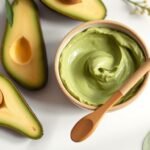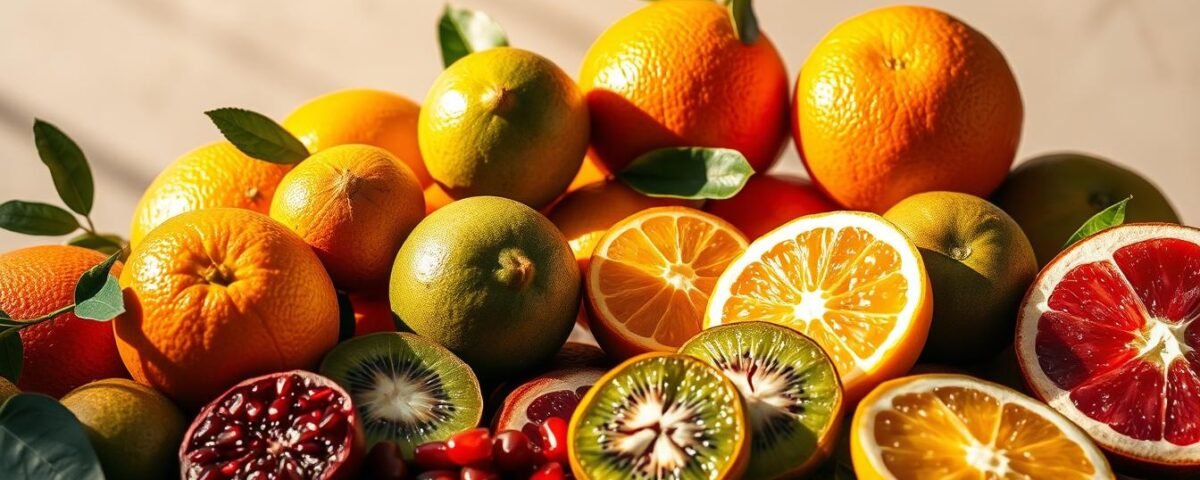
How to Naturally Hydrate Your Skin with These 5 Fruits
March 22, 2025
How to Make an Avocado Face Mask for Deep Hydration
March 22, 2025Did you know that just one medium orange provides over 90% of your daily vitamin C needs? This powerful nutrient isn’t just essential for your immune system—it’s a game-changer for your skin too. From reducing fine lines to boosting radiance, the benefits are hard to ignore.
Take Sarah, for example. After struggling with dull, uneven skin, she started adding more citrus fruits and strawberries to her diet. Within weeks, she noticed a visible glow and smoother texture. Her secret? The antioxidant power of vitamin C.
In this guide, we’ll show you how to harness the power of these nutrient-packed foods for brighter, healthier skin. From creative recipes to skincare tips, we’ve got you covered. Let’s dive in!
Key Takeaways
- Vitamin C is essential for collagen production and skin regeneration.
- Citrus fruits like oranges and grapefruits are excellent sources of this nutrient.
- Regular intake can improve skin texture and reduce signs of aging.
- Combining dietary sources with topical treatments maximizes benefits.
- Simple recipes and skincare routines can make a big difference.
Introduction: Unlocking the Power of Vitamin C for Radiant Skin
Radiant skin starts with the right nutrients, and one powerful ingredient stands out. We’re here to show you how this natural powerhouse can transform your complexion. From boosting glow to fighting signs of aging, the benefits are undeniable.
Why We Believe in Vitamin C for Skincare
We’re passionate about this nutrient because of its proven role in skin health. It’s a key player in collagen production, which keeps your skin firm and youthful. Plus, its antioxidant properties help fight free radicals, the main culprits behind premature aging.
“Vitamin C is essential for maintaining skin structure and preventing damage caused by environmental stressors.”
Studies show that regular intake can reduce wrinkles by up to 25% and improve skin texture significantly. It’s not just about looking good—it’s about feeling confident in your skin.
What to Expect from Our Guide
Our guide is packed with actionable tips to help you make the most of this nutrient. Here’s a sneak peek:
- Discover the best food sources for glowing skin.
- Learn how to incorporate these ingredients into your daily diet.
- Explore creative recipes and skincare routines for maximum benefits.
To give you a head start, here’s a quick comparison of top sources:
| Food | Amount per Cup (mg) |
|---|---|
| Orange | 96 |
| Bell Pepper | 190 |
| Broccoli | 81 |
| Strawberries | 89 |
We’re excited to guide you on this journey to healthier, brighter skin. Let’s get started!
Understanding the Role of Vitamin C in Skin Health
Your skin’s health relies on a key nutrient that works wonders behind the scenes. This nutrient is essential for maintaining firmness, elasticity, and a radiant glow. Let’s dive into the science behind its benefits.
The Science Behind Vitamin C and Collagen
Collagen is the protein that keeps your skin firm and youthful. Without it, skin loses its elasticity, leading to wrinkles and sagging. This nutrient plays a critical role in collagen production, acting as a co-factor for enzymes that stabilize collagen fibers.
Research shows that this nutrient helps synthesize collagen in the dermis, the skin’s middle layer. A study published in the Dermatology Research Journal found that regular intake can improve skin texture by up to 25%. That’s why it’s often called the “anti-aging nutrient.”
“Collagen makes up 75% of the dermis dry weight, and this nutrient is essential for its synthesis.”
In addition to collagen, this nutrient is a powerful antioxidant. It fights free radicals, unstable molecules that damage skin cells and accelerate aging. By neutralizing these harmful molecules, it helps protect your skin from environmental stressors like UV rays and pollution.
Here’s a quick look at how much of this nutrient you can get from common foods:
| Food | Amount per Cup (mg) |
|---|---|
| Orange | 96 |
| Bell Pepper | 190 |
| Broccoli | 81 |
| Strawberries | 89 |
Meeting your daily needs is easier than you think. Just one medium orange provides over 90% of the recommended intake. Adding a variety of these foods to your diet ensures your skin gets the support it needs to stay healthy and vibrant.
Exploring Vitamin C Fruits: Nature’s Skincare Secret
Nature has gifted us with a treasure trove of nutrient-packed options that can transform your skin. These natural sources are not only delicious but also packed with benefits that go beyond just taste. Let’s dive into the world of foods that can help you achieve a radiant complexion.
Highlighting Top Fruit Sources
Some of the most common foods in your kitchen are powerhouses for skin health. Oranges, for example, are a classic choice. Just one medium orange provides over 90% of your daily needs for this essential nutrient. But they’re not the only option. Guavas, strawberries, and even bell peppers are excellent sources.
Here’s a quick look at the nutritional values of these foods:
- Oranges: 96 mg per cup
- Guavas: 377 mg per cup
- Strawberries: 89 mg per cup
- Bell Peppers: 190 mg per cup
These foods don’t just provide this nutrient—they’re also rich in antioxidants and fiber. These additional benefits help protect your skin from damage and keep your body healthy. For example, strawberries contain ellagic acid, which helps prevent UV damage and reduce inflammation.
Whole foods like these are far superior to processed supplements. They contain co-factors like flavonoids and enzymes that enhance the stability and efficacy of the nutrient. This means your body can absorb and use it more effectively.
Incorporating these foods into your daily routine is easier than you think. Add a handful of strawberries to your morning yogurt or enjoy a fresh orange as a snack. These small changes can make a big difference in your skin’s health and appearance.
Stay tuned for the next section, where we’ll share creative ways to enjoy these nutrient-rich foods every day. Your journey to glowing skin starts here!
Nutrient Density: Ranking Foods Rich in Vitamin C
When it comes to boosting your health, some foods pack a stronger punch than others. Nutrient density is a measure of how much of a specific nutrient a food provides relative to its calorie content. Understanding this can help you make smarter choices for your diet and overall well-being.

Comparing Nutrient Data from Leading Sources
Not all foods are created equal. Some are true powerhouses, offering significantly higher amounts of essential nutrients. For example, guavas top the list with 377 mg per cup, while oranges provide 96 mg. Here’s a detailed comparison of top sources:
| Food | Amount per Cup (mg) |
|---|---|
| Guava | 377 |
| Kiwi | 167 |
| Bell Pepper | 152 |
| Strawberry | 98 |
| Orange | 96 |
How to Identify High Vitamin C Density
Identifying nutrient-dense foods is easier than you think. Start by checking nutrition labels for the amount of essential nutrients per serving. Online tools and databases can also help you compare options. For example, bell peppers and kiwi are excellent choices because they provide a high amount of this nutrient per calorie.
Here’s a quick tip: Look for foods that offer at least 20% of the daily value per serving. This ensures you’re getting a significant benefit without overloading on calories. Incorporating these foods into your daily intake can support your health and help prevent deficiencies.
Incorporating Vitamin C Fruits into Our Skincare Routine
Transforming your skincare routine starts with what you put on your plate. By adding nutrient-rich options to your meals, you can support a brighter, healthier complexion. Let’s explore practical ways to make this a seamless part of your day.
Dietary Tips for a Brighter Complexion
Start your morning with a smoothie packed with fresh ingredients. Blend strawberries, kiwi, and a splash of orange juice for a refreshing, nutrient-dense drink. This simple recipe not only tastes great but also provides a significant boost to your skin’s health.
For lunch, try adding colorful bell peppers to your salads. These vegetables are a fantastic source of essential nutrients and add a satisfying crunch. Pair them with leafy greens and a citrus-based dressing for a meal that’s as vibrant as your skin.
Snack smarter by keeping seasonal produce on hand. A handful of fresh berries or a sliced orange can satisfy your sweet tooth while delivering powerful antioxidants. These small changes can make a big difference in your overall nutrition.
Dinner is another opportunity to get creative. Roast broccoli and cauliflower with a sprinkle of lemon zest for a flavorful side dish. This combination not only enhances the taste but also maximizes the nutrient content of your meal.
When selecting produce, opt for seasonal options to ensure freshness and potency. For example, citrus fruits like oranges and grapefruits are at their peak during winter months. Choosing seasonal items supports both your health and local farmers.
For more insights on sourcing high-quality produce, check out our guide on wholesale fruit suppliers. It’s packed with tips to help you make informed choices for your diet.
By incorporating these tips into your routine, you’ll not only enjoy delicious meals but also see visible improvements in your skin. Let’s make your diet as vibrant as your complexion!
Creative Recipes Featuring Citrus and Other Vitamin C-Rich Produce
Let’s bring some creativity to your kitchen with recipes that are as nourishing as they are delicious. These dishes are packed with ingredients that support your health and add a burst of flavor to your meals. From refreshing smoothies to crunchy snacks, we’ve got you covered.
Refreshing Smoothies and Juices
Start your day with a vibrant smoothie that’s both tasty and beneficial. Try blending 2 cups of fresh pineapple, 1 large mango, and 2 seedless oranges. Add a 2-inch piece of ginger for an anti-inflammatory boost. This combo provides over 100 mg of essential nutrients per serving.
For a lighter option, mix strawberries, kiwi, and a splash of lime juice. This tangy blend is perfect for a midday pick-me-up. Each cup delivers a refreshing dose of antioxidants and natural sweetness.
Innovative Salads and Snacks
Salads don’t have to be boring. Combine cantaloupe, cherry tomatoes, and fresh basil for a unique twist. Drizzle with a lemon vinaigrette for added zest. This dish is a great source of hydration and flavor.
For a crunchy snack, slice red pepper strips and pair them with hummus. This combo is rich in fiber and nutrients, making it a guilt-free treat. You can also add leafy greens for an extra health boost.
These recipes are easy to adapt for any meal or occasion. Whether you’re hosting a gathering or enjoying a quiet dinner, these dishes will keep your meals exciting and nutritious. Let’s get cooking!
Beyond Fruits: Other Natural Sources of Vitamin C
While citrus often steals the spotlight, there’s a whole world of nutrient-rich options beyond just fruits. Vegetables and supplements can also play a key role in meeting your daily needs. Let’s explore these alternatives and how they can benefit your health.
Vegetable Powerhouses and Their Benefits
Vegetables like broccoli, kale, and red cabbage are excellent sources of this essential nutrient. For example, one cup of chopped broccoli provides 81 mg, which is 88% of the recommended daily intake. These options are not only nutrient-dense but also versatile in recipes.
Red cabbage is another standout, offering 50 mg per cup. It’s rich in antioxidants and can be enjoyed raw in salads or cooked in stir-fries. Including these vegetables in your meals ensures you’re getting a variety of nutrients that support overall health.
Supplements vs. Whole Foods: What Works Best
While supplements can be convenient, whole foods often provide better absorption and additional health benefits. Foods like bell peppers and kale contain co-factors like flavonoids, which enhance nutrient stability and effectiveness.
“Whole foods offer a synergy of nutrients that supplements can’t replicate. They’re the best way to support long-term health.”
Supplements can be useful for those with dietary restrictions or specific health needs. However, they should complement, not replace, a balanced diet. Always consult a healthcare professional before starting any new supplement regimen.
By incorporating a mix of vegetables and whole foods, you can ensure you’re getting the full spectrum of nutrients your body needs. Variety is key to maintaining a healthy diet and supporting your skin and immune function.
Seasonal Guide: Optimizing Our Vitamin C Intake Year-Round
Seasonal changes bring fresh opportunities to nourish your skin with the right foods. By aligning your diet with nature’s rhythm, you can enjoy the best flavors and nutritional benefits each season has to offer. Let’s explore how to make the most of seasonal produce for glowing skin and overall health.
Seasonal Shopping and Preparation Tips
Seasonal variations affect the availability and nutritional potency of nutrient-rich options. For example, citrus fruits like oranges and grapefruits peak in winter, while strawberries and bell peppers shine in spring and summer. Choosing local, in-season produce ensures maximum freshness and flavor.
Here are some tips to help you shop and prepare seasonal foods:
- Shop Local: Visit farmers’ markets or join a CSA (Community Supported Agriculture) program to access fresh, seasonal options.
- Store Properly: Keep fruits and vegetables in cool, dry places or refrigerate them to preserve their nutrients.
- Prepare Smartly: Eat raw or lightly cooked produce to retain their nutritional value. Steaming or sautéing are great options.
Creative recipes can make seasonal eating exciting. Try adding sliced strawberries to your morning oatmeal or blending oranges into a refreshing smoothie. These simple enhancements can boost your daily nutrient intake while keeping your meals delicious.
“Seasonal eating not only supports your health but also connects you to the natural cycle of the year.”
Planning your daily menus around seasonal availability ensures consistent nutrient intake. For example, focus on winter citrus for immune support and summer berries for antioxidants. By adapting to seasonal changes, you can maintain a balanced diet that benefits your skin and overall well-being.
Practical Tips for Maximizing the Antioxidant Power of Your Diet
Small changes in your daily routine can unlock the full potential of nutrient-rich foods for glowing skin. By focusing on meal planning and proper food handling, you can make the most of these natural benefits.
Daily Meal Planning for Glowing Skin
Start by incorporating a variety of colorful produce into your meals. For breakfast, add a handful of berries to your yogurt or oatmeal. At lunch, toss bell peppers and spinach into your salad. These simple swaps ensure you’re getting a steady intake of essential nutrients.
Planning ahead can save time and keep you on track. Prepare snacks like sliced veggies or a small cup of citrus segments to enjoy throughout the day. This approach makes it easier to maintain a balanced diet, even with a busy schedule.
Preserving Vitamin C in Cooking and Storage
To retain the maximum benefits, handle your produce with care. Store fruits and vegetables in a cool, dry place or refrigerate them to prevent nutrient loss. When cooking, opt for methods like steaming or sautéing, which preserve more nutrients compared to boiling.
Remember, fresh is best. Consume raw options like salads or smoothies whenever possible. By following these tips, you’ll ensure your meals are as nutritious as they are delicious.
With these strategies, you can transform your diet into a powerful tool for radiant skin and overall health. Start today and see the difference!
FAQ
Why is vitamin C important for our skin?
It helps boost collagen production, protects against damage from free radicals, and brightens our complexion. It’s a key nutrient for healthy, glowing skin.
Which fruits are the best sources of vitamin C?
Oranges, strawberries, kiwis, and guavas are excellent choices. These are packed with this essential nutrient and are easy to add to our daily diet.
Can we get vitamin C from vegetables too?
Absolutely! Bell peppers, broccoli, and kale are great vegetable sources. They’re nutrient-dense and versatile for meals.
How can we incorporate vitamin C-rich foods into our skincare routine?
Eating these foods regularly helps from the inside out. We can also use serums or creams with this nutrient for topical benefits.
Are supplements as effective as whole foods for vitamin C intake?
While supplements can help, whole foods provide additional antioxidants and nutrients that work together for better skin health.
What’s the best way to preserve vitamin C in our meals?
Cooking methods like steaming or eating raw help retain this nutrient. Avoid overcooking or prolonged storage to maximize its benefits.
How does seasonal eating affect our vitamin C intake?
Eating seasonal produce ensures we get the freshest and most nutrient-rich options. Citrus fruits in winter and berries in summer are perfect examples.
Can vitamin C help reduce the risk of skin damage?
Yes, its antioxidant properties protect our skin from UV damage and environmental stressors, reducing the risk of premature aging.



